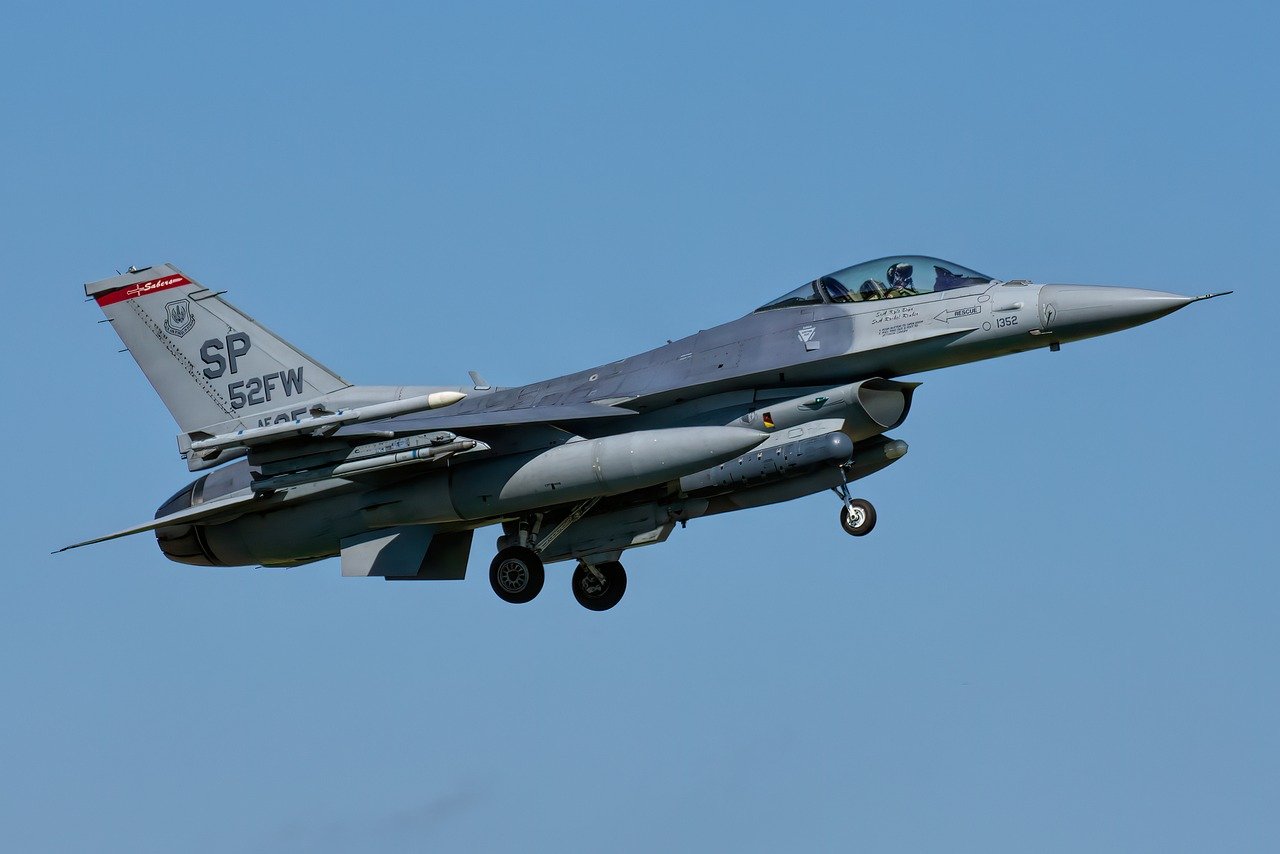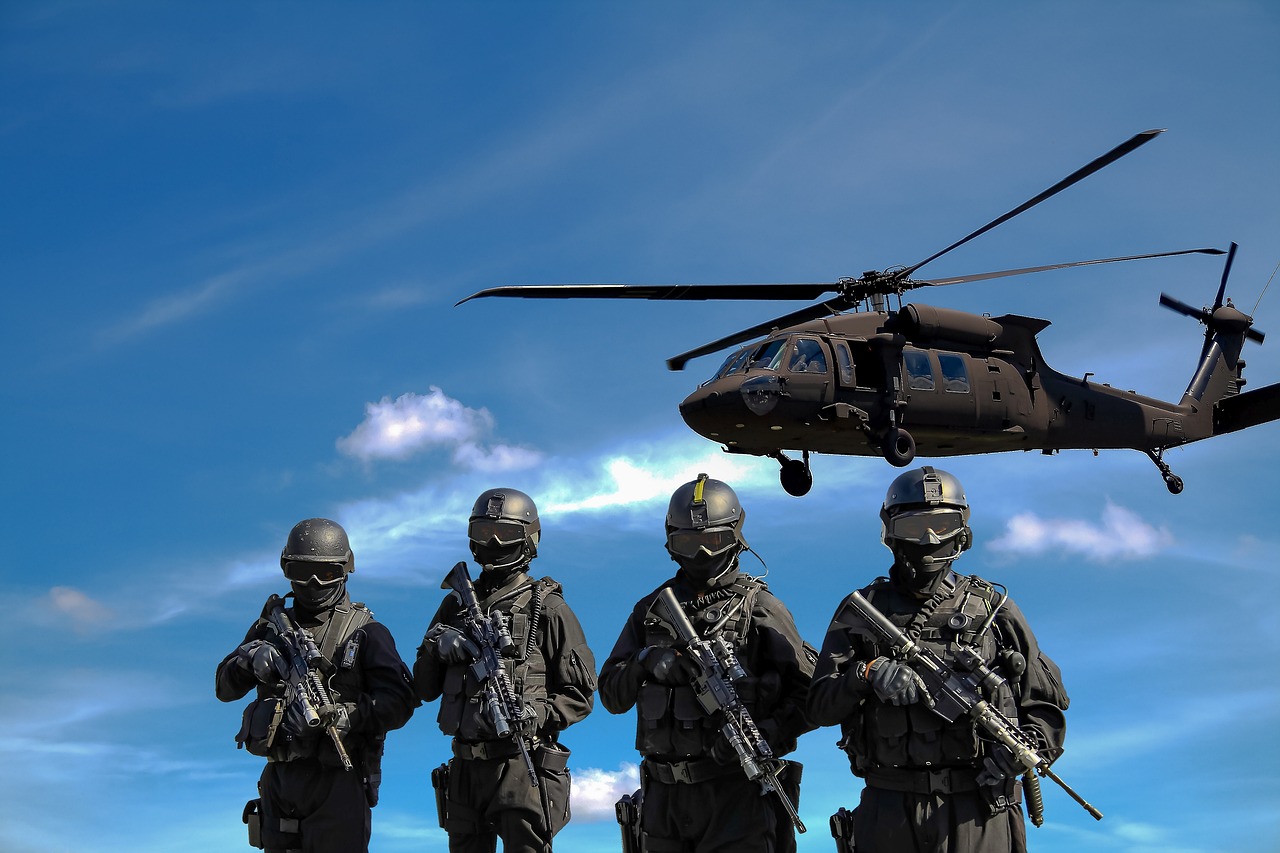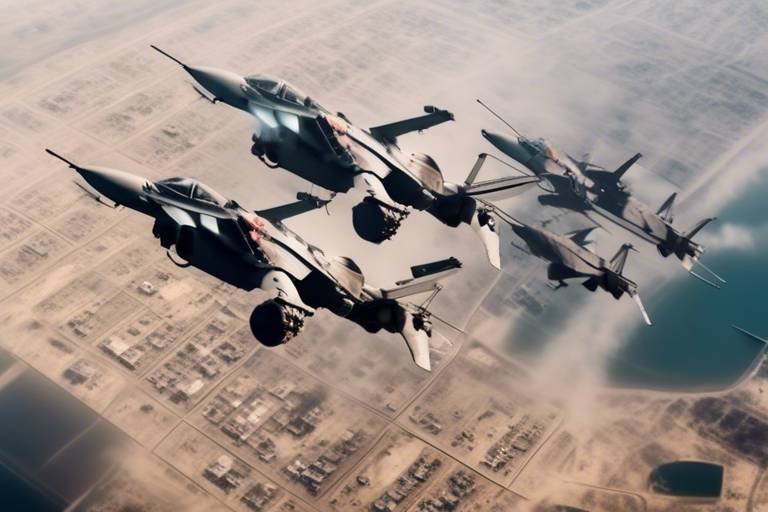The Future of Military R&D - Trends to Watch
The landscape of military research and development (R&D) is undergoing a dramatic transformation, driven by the relentless pace of technological advancement and the ever-evolving nature of global threats. As we look to the future, it’s clear that the **military sector** is not just playing catch-up; it’s actively shaping the battlefield of tomorrow. With innovations in artificial intelligence, robotics, cybersecurity, and more, the implications for national security and defense capabilities are profound. But what exactly can we expect in the coming years? Let’s dive into some of the most exciting trends that are set to redefine military R&D.
One of the most significant trends in military R&D is the increasing investment in **cutting-edge technologies**. The military is harnessing the power of technologies such as artificial intelligence (AI), robotics, and quantum computing. These advancements are expected to revolutionize warfare, enhancing operational efficiency and effectiveness. For instance, AI is not just about automating tasks; it’s about creating systems that can learn and adapt in real-time, providing a strategic edge on the battlefield. Imagine a future where drones equipped with AI can assess threats and make decisions faster than a human operator ever could!
As cyber threats become more sophisticated, the military is prioritizing **cybersecurity innovations** to protect sensitive information and critical infrastructure. With cyber warfare becoming a reality, the military recognizes that safeguarding its digital assets is just as crucial as protecting physical ones. This shift in focus has led to the development of advanced cybersecurity measures that leverage the latest technologies to thwart potential attacks.
Artificial intelligence is playing a crucial role in enhancing cybersecurity measures. It enables faster threat detection and response in military operations. By analyzing patterns and anomalies in data, AI can identify potential threats before they escalate into serious breaches. This proactive approach is akin to having a **digital watchtower** that never sleeps, constantly scanning for signs of trouble.
Machine learning algorithms are being developed to analyze vast amounts of data, improving the military's ability to anticipate and mitigate cyber threats effectively. These algorithms can sift through terabytes of information, identifying trends and anomalies that human analysts might miss. This capability is like having a **super-intelligent assistant** that can predict the future based on historical data.
Moreover, automated systems are being designed to respond to cyber threats in real-time. This significantly reduces the time it takes to counteract potential breaches, allowing military personnel to focus on strategic decisions rather than getting bogged down by routine responses. Think of it as a **firefighter** that not only detects a fire but also extinguishes it before it can spread.
The military is also focusing on training personnel to deal with cybersecurity challenges, fostering a culture of vigilance and preparedness. This comprehensive training ensures that all members are equipped with the knowledge and skills necessary to combat cyber threats effectively. After all, even the best technology needs skilled operators to maximize its potential.
Understanding the shifting landscape of military funding is essential, as governments prioritize certain areas of R&D to maintain technological superiority in defense. The allocation of resources can dictate which technologies will flourish and which may fall by the wayside. As we navigate this complex environment, several key trends emerge.
Collaboration with private tech companies is becoming more common, allowing for rapid innovation and access to commercial technologies that can be adapted for military use. This partnership is akin to a **strategic alliance**, where both parties benefit from shared knowledge and resources, ultimately leading to faster advancements in military capabilities.
Global political dynamics also influence military funding decisions. Shifting alliances and emerging threats shape priorities and investments in specific technologies and capabilities. For instance, a rising geopolitical tension may prompt an increase in funding for advanced surveillance systems or missile defense technologies. It’s a constant game of chess, where the stakes are national security and global stability.
As military technologies advance, ethical questions arise regarding their implications. The potential for **autonomous weapons** and their impact on warfare raises critical concerns about accountability and the potential for unintended consequences. How do we ensure that these powerful technologies are used responsibly?
The development of autonomous weapons systems presents ethical dilemmas regarding accountability. Who is responsible if an autonomous drone makes a mistake? These questions challenge our understanding of warfare and the moral implications of using machines in combat scenarios.
Establishing regulatory frameworks is crucial to ensure that military R&D aligns with international laws and ethical standards. This promotes responsible innovation, ensuring that advancements in technology do not outpace our ability to manage them ethically. It’s a delicate balance between **innovation and responsibility**, and it’s one that we must navigate carefully.
- What are the key technologies shaping the future of military R&D?
Key technologies include AI, robotics, quantum computing, and advanced cybersecurity measures.
- How is the military addressing cybersecurity threats?
The military is investing in AI-driven cybersecurity innovations and training programs for personnel.
- What role does private sector collaboration play in military R&D?
Collaboration with private tech companies accelerates innovation and provides access to cutting-edge technologies.
- What ethical concerns arise from autonomous weapons development?
Concerns include accountability for mistakes and the moral implications of using machines in warfare.

Emerging Technologies in Defense
This article explores emerging trends in military research and development, focusing on technological advancements, funding strategies, and the implications for national security and defense capabilities in the coming years.
The landscape of military defense is undergoing a remarkable transformation, driven by cutting-edge technologies that promise to redefine how wars are fought and won. The military is increasingly investing in innovations like artificial intelligence (AI), robotics, and quantum computing. These advancements are not just incremental improvements; they represent a paradigm shift that could enhance operational efficiency and effectiveness on the battlefield.
For instance, AI is being integrated into various military applications, allowing for smarter decision-making processes. Imagine a battlefield where drones equipped with AI can autonomously assess threats and make real-time decisions, all while minimizing human error. This is not science fiction; it's rapidly becoming a reality. Robotics, too, are playing a pivotal role, with unmanned ground vehicles and aerial drones being deployed for reconnaissance and logistics. The potential for these technologies to operate in hostile environments, where human presence might be too risky, is enormous.
Moreover, quantum computing is on the horizon, promising to revolutionize data processing capabilities. With its ability to solve complex problems at unprecedented speeds, quantum computing could significantly enhance cryptography and secure communications, making military operations more robust against espionage and cyber threats. The implications of these technologies extend beyond mere efficiency; they could fundamentally alter the balance of power in global defense.
To give you a clearer picture, let's look at some of the key technologies and their potential impacts:
| Technology | Potential Impact |
|---|---|
| Artificial Intelligence | Enhanced decision-making and threat assessment |
| Robotics | Reduced risk to human life in combat zones |
| Quantum Computing | Revolutionized data processing and secure communications |
As exciting as these technologies are, they also come with their own set of challenges and considerations. For instance, the integration of AI into military operations raises questions about autonomy and accountability. If an AI system makes a critical decision in combat, who is responsible for that choice? This ethical dilemma must be addressed as we advance in our technological capabilities.
In summary, the emerging technologies in defense are not just reshaping military capabilities; they are redefining the very nature of warfare itself. As these innovations continue to develop, it will be crucial for military leaders and policymakers to navigate the complexities they bring, ensuring that advancements are harnessed responsibly and ethically.
- What role does AI play in military operations?
AI enhances decision-making, threat detection, and operational efficiency, allowing for faster and more accurate responses in combat situations. - How are robotics being used in defense?
Robotics are utilized for reconnaissance, logistics, and even combat roles, reducing the risk to human soldiers in dangerous environments. - What is quantum computing's impact on military technology?
Quantum computing has the potential to revolutionize data processing, enabling secure communications and advanced cryptography. - What ethical concerns arise from emerging military technologies?
Ethical concerns include accountability for AI decisions, the potential for autonomous weapons, and the implications of increased military capabilities on global security.

Cybersecurity Innovations
As we dive deeper into the digital age, the military landscape is undergoing a seismic shift, particularly in the realm of . With the ever-increasing sophistication of cyber threats, military research and development are prioritizing cutting-edge solutions to safeguard sensitive data and critical infrastructure. Imagine a world where military operations are not just about physical might but also about defending against invisible enemies lurking in the cyber realm. This is not science fiction; it’s the reality we are facing today.
One of the most exciting developments in this arena is the integration of artificial intelligence (AI) into cybersecurity measures. AI is not just a buzzword; it's transforming how military organizations detect and respond to cyber threats. Traditional methods of threat detection can be slow and reactive, but with AI, the military can leverage real-time data analysis to identify anomalies and potential threats before they escalate. Think of AI as a vigilant guard dog—always on alert, ready to bark at any sign of trouble.
Within the broader category of AI, machine learning algorithms are being developed to sift through massive amounts of data. These algorithms can learn from past incidents, identifying patterns that may indicate a cyber attack. The result? A military that can anticipate and mitigate threats effectively, much like a chess player who can predict their opponent's moves several steps ahead. This proactive approach not only enhances operational efficiency but also saves critical time in responding to potential breaches.
Imagine trying to find a needle in a haystack; that's what traditional cybersecurity efforts often feel like. However, with machine learning, the haystack is analyzed, and the needle is highlighted for the cybersecurity team. These algorithms can process vast datasets, providing insights that were previously unimaginable. They can detect unusual patterns of behavior within networks, flagging them for further investigation. This capability is crucial in a military context, where every second counts, and the stakes are incredibly high.
Moreover, the development of automated threat response systems is revolutionizing how the military handles cyber threats. These systems can respond to potential breaches in real-time, significantly reducing the time it takes to counteract attacks. Picture a fire alarm that not only alerts you to danger but also automatically dials the fire department and activates sprinklers. That's the kind of efficiency automation brings to cybersecurity. By minimizing human intervention, these systems allow military personnel to focus on strategic decisions rather than getting bogged down in the minutiae of threat management.
However, technology alone cannot combat cyber threats. The military is also investing in cybersecurity training programs to equip personnel with the skills needed to navigate this complex landscape. These programs foster a culture of vigilance and preparedness, ensuring that every member of the military is aware of the potential risks and knows how to respond effectively. Just as soldiers undergo rigorous training for physical combat, they must also be trained to face the challenges of cyber warfare.
This holistic approach to cybersecurity—combining advanced technology with comprehensive training—creates a robust defense mechanism. It’s akin to building a fortress that not only has high walls but also a well-trained guard. As we move forward, it’s clear that military R&D will continue to innovate, addressing the evolving challenges posed by cyber threats.
- What role does AI play in military cybersecurity? AI enhances threat detection and response times, allowing for proactive measures against cyber attacks.
- How do machine learning algorithms improve cybersecurity? They analyze large datasets to identify patterns and anomalies that indicate potential threats.
- What is automated threat response? It refers to systems that can respond to cyber threats in real-time, minimizing human intervention.
- Why is cybersecurity training important in the military? Training ensures personnel are equipped to handle cyber threats effectively, fostering a culture of vigilance.

AI in Cyber Defense
Artificial Intelligence (AI) is not just a buzzword; it’s a game-changer in the realm of cyber defense. As cyber threats grow more sophisticated, the military is turning to AI to bolster its defenses. Imagine having a digital watchdog that never sleeps, constantly scanning for threats and anomalies. This is the kind of power AI brings to the table. By leveraging machine learning and data analytics, military operations can now detect potential threats faster than ever before, ensuring that they stay one step ahead of cybercriminals and hostile entities.
The integration of AI in cyber defense is akin to giving a soldier a high-tech exoskeleton; it enhances capabilities and increases efficiency. For instance, AI can process vast amounts of data from multiple sources, identifying patterns that a human might overlook. This capability is crucial in a world where data is generated at an unprecedented rate. As a result, military personnel can focus on strategic decision-making rather than getting bogged down in the minutiae of data analysis.
One of the most exciting applications of AI in cyber defense is its ability to automate threat detection. Traditional methods often involve manual monitoring, which can be slow and prone to error. However, with AI-powered systems, the military can achieve real-time monitoring and response. This means that as soon as a potential threat is identified, the system can initiate countermeasures almost instantaneously. This rapid response is critical in mitigating the impact of cyberattacks, potentially saving sensitive data and critical infrastructure from destruction.
To illustrate the effectiveness of AI in cyber defense, consider the following table that outlines the key advantages of implementing AI technologies in military cybersecurity operations:
| Advantage | Description |
|---|---|
| Speed | AI can analyze data and detect threats in real-time, significantly reducing response times. |
| Accuracy | Machine learning algorithms improve over time, enhancing the precision of threat detection. |
| Scalability | AI systems can handle large volumes of data, making them suitable for extensive military networks. |
| Cost-effectiveness | By automating processes, AI reduces the need for extensive human resources in monitoring tasks. |
Furthermore, AI is not just about detection; it also plays a pivotal role in predictive analysis. By analyzing historical data and current trends, AI can make educated predictions about potential future attacks. This foresight allows military strategists to proactively strengthen their defenses and prepare for possible scenarios. In a landscape where cyber threats are constantly evolving, this predictive capability is invaluable.
In conclusion, the role of AI in cyber defense is expanding rapidly, transforming how military operations protect against cyber threats. It’s not just about reacting to attacks anymore; it’s about anticipating them. As technology continues to evolve, we can expect AI to become an even more integral part of military cyber strategy, ensuring that nations remain secure in an increasingly digital world.
- How does AI improve threat detection in cyber defense?
AI enhances threat detection by analyzing vast amounts of data at high speeds, identifying patterns, and recognizing anomalies that may indicate a cyber threat. - Can AI fully replace human cybersecurity experts?
While AI can automate many processes and improve efficiency, human expertise is still crucial for strategic decision-making and complex problem-solving. - What are the ethical implications of using AI in military cyber defense?
The use of AI raises ethical questions about accountability and decision-making in warfare, particularly concerning autonomous systems that may operate without human intervention.

Machine Learning Algorithms
In the rapidly evolving landscape of military research and development, are emerging as a game-changer. These algorithms are designed to sift through vast amounts of data, identifying patterns and anomalies that would be nearly impossible for humans to detect in real-time. Imagine having a digital assistant that can predict potential cyber threats before they even manifest—this is the power that machine learning brings to the table.
One of the most exciting aspects of machine learning in military applications is its ability to enhance situational awareness. By analyzing data from various sources—such as satellite imagery, sensor data, and social media feeds—these algorithms can provide military personnel with actionable insights, allowing them to make informed decisions swiftly. For instance, during a conflict, machine learning can help identify enemy movements or predict their strategies based on historical data, giving a significant tactical advantage.
Moreover, the adaptability of machine learning algorithms is another factor that makes them indispensable. As they process more data, they continuously improve their accuracy and effectiveness. This means that the more they are used, the smarter they become. This capability is particularly crucial in cybersecurity, where threats are constantly evolving. By employing machine learning, the military can stay one step ahead of cyber adversaries, anticipating their moves and fortifying defenses accordingly.
To illustrate the impact of these algorithms, consider the following table that outlines some key applications of machine learning in military contexts:
| Application | Description | Benefit |
|---|---|---|
| Threat Detection | Identifying potential cyber threats from network traffic data. | Faster response times and improved security posture. |
| Predictive Analytics | Forecasting enemy movements based on historical data. | Enhanced operational planning and execution. |
| Data Fusion | Integrating information from multiple sources for a comprehensive view. | Improved situational awareness and decision-making. |
While the benefits of machine learning algorithms are clear, it's also important to recognize the challenges that come with their implementation. For instance, data privacy and security concerns must be addressed to ensure that sensitive information is not compromised. Additionally, there’s the question of accountability—who is responsible if a machine learning system makes a critical error? As these technologies continue to advance, the military must navigate these ethical considerations carefully.
In conclusion, machine learning algorithms represent a significant leap forward in military capabilities. Their ability to process and analyze data at lightning speed not only enhances operational efficiency but also strengthens national security. As we look to the future, it's evident that these algorithms will play a pivotal role in shaping the next generation of military strategies and technologies.
- What are machine learning algorithms?
Machine learning algorithms are computational models that enable systems to learn from data, identify patterns, and make predictions without being explicitly programmed for specific tasks.
- How are they used in military applications?
In military contexts, machine learning algorithms are used for threat detection, predictive analytics, and data fusion to enhance situational awareness and operational efficiency.
- What are the ethical concerns associated with machine learning in defense?
Ethical concerns include data privacy, accountability for errors made by algorithms, and the potential for misuse of technology in warfare.

Automated Threat Response
In today’s fast-paced digital battlefield, the military is embracing the concept of to combat the ever-evolving landscape of cyber threats. Imagine a scenario where threats are detected and neutralized without human intervention—this is not just a futuristic dream; it’s becoming a reality. Automated systems are being developed to respond to cyber threats in real-time, significantly reducing the time it takes to counteract potential breaches. This capability is crucial because, in the world of cyber warfare, seconds can mean the difference between thwarting an attack and suffering a catastrophic breach.
These automated systems utilize advanced algorithms and machine learning techniques to analyze incoming data streams continuously. They can identify patterns and anomalies that may indicate a cyber attack is imminent. By doing so, they empower military personnel to focus on strategic decision-making rather than getting bogged down in the minutiae of data analysis. The integration of automation in threat response not only enhances efficiency but also improves accuracy. With the sheer volume of data that military networks handle, relying solely on human operators is no longer feasible.
Moreover, the automation of threat responses allows for a layered defense strategy. Here’s how it typically works:
- Detection: Automated systems continuously monitor network traffic for unusual activity.
- Analysis: Once a potential threat is detected, the system analyzes the data to determine its severity and nature.
- Response: Based on predefined protocols, the system can take immediate actions such as isolating affected systems or blocking malicious IP addresses.
- Reporting: After the incident, the system generates reports for human analysts to review and refine future responses.
This approach not only bolsters the military’s cyber defense capabilities but also creates a dynamic environment where learning and adaptation are constant. As these automated systems gather data from various incidents, they evolve, becoming more adept at identifying and responding to new threats. This is akin to training a soldier; the more experience they gain, the better they become at anticipating and countering enemy actions.
However, it’s essential to recognize that while automated threat response systems offer numerous advantages, they are not without challenges. The reliance on automated systems raises questions about trust and accountability. What happens if an automated system misidentifies a benign action as a threat? Who is responsible for the consequences of such an error? Therefore, while automation enhances operational efficiency, it must be complemented by robust oversight and human intervention to ensure that the military can navigate the complexities of cyber warfare effectively.
In conclusion, the future of military cybersecurity will increasingly rely on automated threat response systems. By harnessing the power of automation, the military can enhance its ability to defend against cyber threats, ensuring that national security is maintained in a rapidly changing digital landscape. As we look ahead, it’s clear that the integration of these technologies will be a game-changer in how military operations are conducted in the cyber domain.
- What is automated threat response? Automated threat response refers to systems that can detect and neutralize cyber threats without human intervention, utilizing advanced algorithms and machine learning.
- How does automation improve military cybersecurity? Automation enhances efficiency and accuracy, allowing for faster detection and response to threats, which is crucial in cyber warfare.
- Are there risks associated with automated systems? Yes, risks include potential misidentification of threats and accountability issues, necessitating human oversight.
- What role does machine learning play in automated threat response? Machine learning enables systems to analyze vast amounts of data, improving their ability to identify and respond to new and evolving cyber threats.

Cybersecurity Training Programs
In an era where cyber threats loom larger than ever, the military recognizes that technology alone cannot safeguard sensitive information and critical infrastructure. Human expertise is equally essential. This realization has led to the development of comprehensive aimed at equipping military personnel with the skills necessary to navigate the complex digital landscape. These programs are designed not just to react to threats, but to proactively prepare individuals to anticipate and mitigate potential cyber incidents.
One of the key components of these training programs is the emphasis on real-world simulations. By immersing personnel in realistic cyber-attack scenarios, they gain hands-on experience that is invaluable in understanding the tactics and techniques employed by adversaries. These simulations often include a variety of cyber threats, from phishing attacks to advanced persistent threats (APTs), allowing participants to develop a well-rounded skill set.
Additionally, the military is increasingly focusing on fostering a culture of vigilance and preparedness. This includes not only technical training but also instilling a mindset that prioritizes cybersecurity in every operation. Personnel are taught to recognize the signs of potential breaches and to understand the importance of maintaining security protocols at all times. Continuous education is a vital aspect of this initiative, with regular updates and refresher courses ensuring that skills remain sharp and relevant.
Moreover, collaboration with cybersecurity experts from the private sector enhances these training programs. By leveraging the knowledge of industry leaders, military personnel can learn about the latest trends and technologies in cybersecurity. This partnership not only enriches the training curriculum but also allows for the exchange of ideas and best practices, fostering innovation within military operations.
To illustrate the structure and focus of these training programs, consider the following table:
| Training Component | Description |
|---|---|
| Real-World Simulations | Hands-on experience in realistic cyber-attack scenarios. |
| Continuous Education | Regular updates and refresher courses to keep skills sharp. |
| Collaboration with Experts | Partnerships with private sector cybersecurity leaders to enhance training. |
| Cultural Awareness | Instilling a mindset that prioritizes cybersecurity in all operations. |
Ultimately, these cybersecurity training programs are not just about defending against current threats; they are about preparing for the future. As cyber warfare evolves, so too must the skills and knowledge of military personnel. By investing in comprehensive training, the military is not only enhancing its operational readiness but also ensuring that its personnel are equipped to handle the challenges of an increasingly digital battlefield.
- What is the main goal of military cybersecurity training programs?
The primary goal is to equip military personnel with the skills necessary to effectively respond to and mitigate cyber threats. - How often are training programs updated?
Training programs are regularly updated to reflect the latest trends and technologies in cybersecurity. - Do these programs include hands-on experience?
Yes, they incorporate real-world simulations to provide hands-on experience in dealing with cyber threats. - Is collaboration with the private sector common?
Absolutely, collaboration with cybersecurity experts from the private sector is an integral part of enhancing military training.

Funding and Investment Trends
This article explores emerging trends in military research and development, focusing on technological advancements, funding strategies, and the implications for national security and defense capabilities in the coming years.
The military is increasingly investing in cutting-edge technologies such as AI, robotics, and quantum computing, which are expected to revolutionize warfare and enhance operational efficiency.
As cyber threats become more sophisticated, military R&D is prioritizing cybersecurity innovations to protect sensitive information and critical infrastructure from potential attacks.
Artificial intelligence is playing a crucial role in enhancing cybersecurity measures, enabling faster threat detection and response in military operations.
Machine learning algorithms are being developed to analyze vast amounts of data, improving the military's ability to anticipate and mitigate cyber threats effectively.
Automated systems are being designed to respond to cyber threats in real-time, significantly reducing the time it takes to counteract potential breaches.
The military is also focusing on training personnel to deal with cybersecurity challenges, fostering a culture of vigilance and preparedness.
Understanding the shifting landscape of military funding is essential, as governments prioritize certain areas of R&D to maintain technological superiority in defense. In recent years, there's been a noticeable shift towards increased investment in advanced technologies that promise to enhance operational capabilities and ensure national security. This trend is driven by the recognition that traditional defense spending alone may not suffice in the face of rapidly evolving threats.
One significant trend is the growing collaboration between the military and the private sector. By partnering with tech giants and innovative startups, the military can tap into cutting-edge commercial technologies that can be rapidly adapted for military applications. This collaboration not only accelerates innovation but also helps in acquiring technologies that might otherwise take years to develop internally.
Furthermore, global political dynamics play a crucial role in shaping military funding decisions. For instance, tensions between nations can lead to increased defense budgets as countries seek to bolster their military capabilities. It's a bit like a game of chess; each move made by one player influences the strategies of the others. As nations assess their geopolitical standing, they often adjust their funding priorities to ensure they remain competitive.
| Year | Global Military Spending (in billion USD) | Key Areas of Investment |
|---|---|---|
| 2021 | 1981 | Cybersecurity, AI, Robotics |
| 2022 | 2110 | Space Defense, Autonomous Systems |
| 2023 | 2200 | Quantum Computing, Advanced Weaponry |
In addition to these trends, there is also a growing emphasis on sustainable defense technologies. As environmental concerns become more pressing, military organizations are investing in green technologies that not only enhance operational efficiency but also reduce the ecological footprint of military operations. This shift reflects a broader recognition that sustainability is not just a buzzword but a critical consideration for future military planning.
Overall, the landscape of military funding and investment is evolving rapidly, driven by technological advancements, geopolitical factors, and a desire for greater efficiency and sustainability. As we look to the future, it will be fascinating to see how these trends continue to shape the military's research and development efforts.
- What are the primary areas of investment in military R&D?
Military R&D is increasingly focusing on technologies such as AI, cybersecurity, robotics, and quantum computing. - How does global politics influence military funding?
Geopolitical tensions often lead to increased defense budgets as nations strive to enhance their military capabilities. - What role does the private sector play in military R&D?
Collaboration with private tech companies allows the military to access cutting-edge technologies and accelerate innovation. - Why is sustainability important in military R&D?
Investing in sustainable technologies helps reduce the military's ecological footprint while enhancing operational efficiency.

Increased Private Sector Collaboration
In recent years, there has been a noticeable shift in the landscape of military research and development (R&D) towards increased collaboration with the private sector. This trend is not just a fleeting moment; it's a fundamental change that reflects the military's recognition of the innovative capabilities and technological advancements that private companies can offer. Think about it: the tech industry is moving at lightning speed, constantly pushing the boundaries of what's possible. By partnering with these innovators, the military can tap into a wealth of knowledge and resources that would otherwise take years to develop internally.
One of the main advantages of this collaboration is the acceleration of technological advancements. Private companies, especially those in the tech sector, are often at the forefront of breakthroughs in areas such as artificial intelligence, robotics, and cybersecurity. By working together, the military can leverage these advancements to enhance its operational capabilities. For instance, consider how companies like SpaceX have revolutionized space technology; similar partnerships could lead to significant improvements in military logistics and operational readiness.
Moreover, these collaborations are not just about technology transfer; they also foster a culture of innovation and agility. The military can adopt practices from the private sector, such as agile development methodologies, which emphasize rapid prototyping and iterative testing. This approach allows for a more dynamic response to emerging threats, ensuring that military capabilities remain relevant in an ever-changing global landscape.
However, this collaboration does come with its challenges. Issues surrounding intellectual property, data security, and the ethical implications of using commercial technologies in military applications must be addressed. It's essential to establish clear frameworks that protect sensitive information while promoting innovation. A well-structured partnership can lead to mutual benefits, but both parties must navigate these complexities carefully to avoid potential pitfalls.
To illustrate the impact of this collaboration, let's take a look at some examples:
| Company | Technology | Military Application |
|---|---|---|
| Palantir Technologies | Data Analytics | Intelligence and Surveillance |
| Boston Dynamics | Robotics | Logistics and Support |
| Microsoft | Cloud Computing | Data Management and Operations |
As we look to the future, the importance of private sector collaboration in military R&D cannot be overstated. With the rapid pace of technological change, the military must remain adaptable and open to new ideas. By embracing partnerships with innovative companies, the military can ensure that it stays ahead of potential adversaries and continues to protect national security effectively.
- Why is private sector collaboration important for military R&D?
Private sector collaboration brings in innovative technologies and practices that can enhance military capabilities and operational efficiency. - What are some challenges of collaborating with private companies?
Challenges include managing intellectual property rights, ensuring data security, and addressing ethical implications of using commercial technologies in military operations. - How does collaboration with the private sector accelerate technological advancements?
Private companies often develop new technologies faster than the military can, allowing for quicker integration of cutting-edge solutions into military operations.

Impact of Global Politics
This article explores emerging trends in military research and development, focusing on technological advancements, funding strategies, and the implications for national security and defense capabilities in the coming years.
The military is increasingly investing in cutting-edge technologies such as AI, robotics, and quantum computing, which are expected to revolutionize warfare and enhance operational efficiency.
As cyber threats become more sophisticated, military R&D is prioritizing cybersecurity innovations to protect sensitive information and critical infrastructure from potential attacks.
Artificial intelligence is playing a crucial role in enhancing cybersecurity measures, enabling faster threat detection and response in military operations.
Machine learning algorithms are being developed to analyze vast amounts of data, improving the military's ability to anticipate and mitigate cyber threats effectively.
Automated systems are being designed to respond to cyber threats in real-time, significantly reducing the time it takes to counteract potential breaches.
The military is also focusing on training personnel to deal with cybersecurity challenges, fostering a culture of vigilance and preparedness.
Understanding the shifting landscape of military funding is essential, as governments prioritize certain areas of R&D to maintain technological superiority in defense.
Collaboration with private tech companies is becoming more common, allowing for rapid innovation and access to commercial technologies that can be adapted for military use.
The landscape of military research and development is profoundly influenced by global politics. As nations navigate complex diplomatic relationships, their defense priorities shift in response to emerging threats and alliances. For instance, a country may ramp up its R&D funding in response to perceived aggressions from neighboring states or to strengthen its position within international coalitions. Political instability in one region can lead to increased military spending elsewhere as governments seek to protect their interests.
Furthermore, international treaties and agreements often dictate the direction of military R&D. For example, arms control agreements may limit the development of certain technologies, while encouraging innovation in others. Countries may find themselves in a race to develop advanced technologies, such as hypersonic weapons or stealth capabilities, in response to the advancements made by rival nations. This competitive dynamic can lead to a cycle of escalation, where nations feel compelled to invest heavily in R&D to maintain their defense posture.
In addition, the role of international organizations cannot be overlooked. Bodies like NATO and the United Nations often influence national defense strategies and funding decisions. Countries that are part of these alliances may prioritize collaborative R&D efforts to ensure interoperability and collective security. This can lead to shared funding initiatives, where member states pool resources to develop technologies that benefit the entire alliance.
In summary, the impact of global politics on military R&D is multifaceted, involving a delicate balance between national security interests, international relations, and compliance with global standards. As the political landscape continues to evolve, so too will the strategies and investments in military research and development.
The advancement of military technologies raises ethical questions about their implications, including the potential for autonomous weapons and their impact on warfare.
The development of autonomous weapons systems presents ethical dilemmas regarding accountability and the potential for unintended consequences in combat scenarios.
Establishing regulatory frameworks is crucial to ensure that military R&D aligns with international laws and ethical standards, promoting responsible innovation.
- What role does AI play in military R&D? AI enhances operational efficiency and cybersecurity measures, enabling faster threat detection and response.
- How does global politics affect military funding? Political relationships and international treaties influence defense priorities and funding allocations.
- What are the ethical concerns surrounding autonomous weapons? There are significant questions about accountability and the potential for unintended consequences in warfare.

Ethical Considerations in Military R&D
The rapid advancement of military technologies, while promising enhanced defense capabilities, raises significant ethical questions that cannot be ignored. As we delve deeper into the realms of artificial intelligence, robotics, and autonomous systems, we must confront the moral implications of these innovations. It’s not just about how effective a new weapon system can be; it’s about the responsibility that comes with deploying such technologies in real-world scenarios. The potential for misuse, unintended consequences, and the erosion of accountability are at the forefront of these discussions.
One of the most pressing ethical dilemmas is the development of autonomous weapons systems. These systems, capable of making life-and-death decisions without human intervention, challenge our traditional understanding of warfare. Imagine a battlefield where machines decide who lives and who dies. It’s a chilling thought, isn’t it? The question of accountability becomes murky: if an autonomous drone mistakenly targets civilians, who is responsible? The programmer? The military commander? Or the machine itself? Such dilemmas demand urgent attention and a robust dialogue among policymakers, ethicists, and technologists.
Furthermore, the regulatory frameworks surrounding these technologies are still in their infancy. Establishing comprehensive guidelines is essential to ensure that military R&D aligns with international laws and ethical standards. Without such frameworks, there’s a risk that nations might race to develop increasingly lethal technologies without considering the broader implications. In this context, a collaborative approach involving multiple stakeholders—governments, international organizations, and civil society—could foster responsible innovation while addressing the concerns of all parties involved.
To illustrate the complexity of these ethical considerations, consider the following table that outlines key ethical issues alongside potential solutions:
| Ethical Issue | Potential Solutions |
|---|---|
| Accountability for Autonomous Weapons | Develop clear guidelines on human oversight and accountability in decision-making processes. |
| Potential for Misuse | Implement strict regulations on the development and deployment of military technologies. |
| Impact on Civilian Populations | Conduct thorough assessments of potential civilian harm before deploying new technologies. |
| International Compliance | Establish international treaties that govern the use of emerging military technologies. |
As we navigate this complex landscape, it’s crucial to foster a culture of ethical awareness within military R&D. This means training personnel not just in technical skills but also in ethical decision-making. By promoting a mindset that prioritizes ethics alongside innovation, we can better prepare our military for the challenges of the future.
- What are the main ethical concerns regarding military R&D? The primary concerns include accountability for autonomous systems, the potential for misuse, the impact on civilian populations, and compliance with international laws.
- How can we ensure accountability in the use of autonomous weapons? By developing clear guidelines that emphasize human oversight in decision-making processes and establishing robust regulatory frameworks.
- What role do international treaties play in military R&D? International treaties can help set standards and regulations that govern the development and deployment of military technologies, promoting responsible innovation.

Autonomous Weapons Systems
The rise of marks a significant shift in the landscape of modern warfare. These advanced technologies, capable of operating without direct human intervention, bring about a host of benefits and challenges. On one hand, they promise to enhance military effectiveness, allowing for quicker decision-making and improved precision in combat scenarios. Imagine a battlefield where drones can identify and neutralize threats faster than any human soldier could. However, this technological leap raises serious ethical questions that cannot be ignored.
One of the most pressing concerns is the issue of accountability. When a machine makes a decision to engage a target, who is responsible for that action? Is it the programmer, the military command, or the machine itself? This ambiguity can lead to dangerous outcomes, particularly if an autonomous system misidentifies a civilian as a combatant. The potential for unintended consequences in combat scenarios is alarming, prompting discussions among ethicists, military leaders, and policymakers alike.
Moreover, there is the risk of an arms race in autonomous weaponry. As nations develop and deploy these systems, others may feel compelled to follow suit, leading to a destabilizing cycle of military escalation. The implications of such an arms race could be catastrophic, as nations equipped with autonomous systems may engage in conflicts with less regard for human life. This scenario raises the question: are we ready to relinquish control over life-and-death decisions to machines?
To address these challenges, establishing regulatory frameworks is crucial. These frameworks should ensure that the development and deployment of autonomous weapons align with international laws and ethical standards. Such regulations could include guidelines on the use of force, accountability measures, and transparency in military operations involving these systems. By promoting responsible innovation, we can strive to balance the advantages of technological advancements with the need for ethical considerations in warfare.
In conclusion, while autonomous weapons systems hold the potential to revolutionize military operations, they also pose significant ethical dilemmas that must be addressed. As we forge ahead into this new era of warfare, it is imperative that we engage in ongoing dialogue about the implications of these technologies, ensuring that our pursuit of innovation does not come at the cost of our humanity.
- What are autonomous weapons systems?
Autonomous weapons systems are military technologies capable of engaging targets without direct human control, utilizing artificial intelligence and advanced algorithms. - What ethical concerns are associated with autonomous weapons?
Key ethical concerns include accountability for actions taken by these systems, the potential for unintended consequences, and the risk of an arms race in autonomous weaponry. - How can we regulate autonomous weapons systems?
Establishing regulatory frameworks that align with international laws and ethical standards is crucial for ensuring responsible development and deployment of these technologies. - What impact could autonomous weapons have on warfare?
They could enhance military effectiveness and decision-making speed but also raise significant moral and ethical dilemmas regarding human oversight and accountability.

Regulatory Frameworks
The rapid advancement of military technologies has sparked a pressing need for robust that govern their development and deployment. As nations race to enhance their defense capabilities through innovation, the question of how to ensure that these advancements align with ethical standards and international laws becomes increasingly critical. This is not just about keeping pace with technology; it's about ensuring that the very technologies meant to protect us do not inadvertently lead us into ethical quagmires.
One of the key challenges in establishing these frameworks is the inherent complexity of military technologies, especially with the rise of autonomous systems and artificial intelligence. For instance, consider autonomous weapons systems, which are designed to operate without human intervention. The ethical implications of such systems are profound. Who is accountable if an autonomous drone mistakenly targets civilians? How do we ensure that these systems comply with international humanitarian law? These questions highlight the urgent need for comprehensive regulations that can adapt to the evolving landscape of warfare.
Moreover, regulatory frameworks must not only focus on the technologies themselves but also consider the broader implications of their use. This includes addressing issues related to data privacy, cybersecurity, and the potential for misuse of military technologies. As we integrate more advanced technologies into defense systems, we must also ensure that they are protected from cyber threats, which could compromise national security and lead to catastrophic outcomes.
To tackle these challenges, many countries are beginning to develop national and international guidelines that establish clear criteria for the ethical use of military technologies. For example, organizations such as the United Nations are working towards creating international treaties that regulate the use of autonomous weapons. These treaties aim to set standards that ensure accountability and transparency in military operations, thereby fostering trust among nations.
In addition to international efforts, individual countries are also taking steps to create their own regulatory frameworks. This often involves collaboration between government bodies, military organizations, and academic institutions to ensure a comprehensive approach. By fostering dialogue among these stakeholders, nations can develop regulations that not only protect their citizens but also promote responsible innovation in military R&D.
In conclusion, as military technologies continue to evolve at a breakneck pace, the establishment of effective regulatory frameworks is imperative. These frameworks must be flexible enough to adapt to new advancements while firmly rooted in ethical considerations and international law. Only then can we navigate the complexities of modern warfare and ensure that our pursuit of technological superiority does not compromise our moral responsibilities.
- What are regulatory frameworks in military R&D?
Regulatory frameworks are guidelines and rules that govern the development and use of military technologies, ensuring they align with ethical standards and international laws. - Why are ethical considerations important in military technologies?
Ethical considerations are crucial to prevent misuse of technologies, ensure accountability, and protect human rights during military operations. - How can nations ensure compliance with international laws?
Nations can establish treaties and engage in international dialogues to create standards that govern military technologies and their use. - What role does collaboration play in developing regulatory frameworks?
Collaboration among government, military, and academic institutions fosters comprehensive approaches to regulation, ensuring diverse perspectives and expertise are considered.
Frequently Asked Questions
- What are the key emerging technologies in military R&D?
The military is heavily investing in technologies like artificial intelligence, robotics, and quantum computing. These advancements are expected to transform warfare by enhancing operational efficiency and effectiveness on the battlefield.
- How is cybersecurity being addressed in military R&D?
With the rise of sophisticated cyber threats, military R&D is prioritizing cybersecurity innovations. This includes developing advanced AI systems for threat detection and response, as well as training personnel to handle cybersecurity challenges effectively.
- What role does AI play in military cyber defense?
AI is crucial in military cyber defense as it enables faster detection and response to threats. By leveraging machine learning algorithms, the military can analyze large datasets to predict and mitigate potential cyber threats.
- How is funding for military R&D changing?
Funding trends are shifting, with increased collaboration between the military and private tech companies. This partnership allows for rapid innovation and access to commercial technologies that can be adapted for military applications, ensuring technological superiority.
- What ethical considerations are associated with military R&D?
The advancement of military technologies raises important ethical questions, particularly regarding autonomous weapons systems. These systems pose dilemmas about accountability and the potential for unintended consequences in warfare, highlighting the need for responsible innovation.
- Are there regulatory frameworks for military R&D?
Yes, establishing regulatory frameworks is vital to ensure that military R&D aligns with international laws and ethical standards. This helps promote responsible innovation and addresses the ethical implications of new technologies.


















